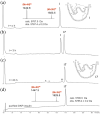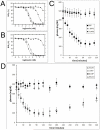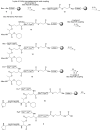Fully convergent chemical synthesis of ester insulin: determination of the high resolution X-ray structure by racemic protein crystallography
- PMID: 23343390
- PMCID: PMC3625376
- DOI: 10.1021/ja311408y
Fully convergent chemical synthesis of ester insulin: determination of the high resolution X-ray structure by racemic protein crystallography
Abstract
Efficient total synthesis of insulin is important to enable the application of medicinal chemistry to the optimization of the properties of this important protein molecule. Recently we described "ester insulin"--a novel form of insulin in which the function of the 35 residue C-peptide of proinsulin is replaced by a single covalent bond--as a key intermediate for the efficient total synthesis of insulin. Here we describe a fully convergent synthetic route to the ester insulin molecule from three unprotected peptide segments of approximately equal size. The synthetic ester insulin polypeptide chain folded much more rapidly than proinsulin, and at physiological pH. Both the D-protein and L-protein enantiomers of monomeric DKP ester insulin (i.e., [Asp(B10), Lys(B28), Pro(B29)]ester insulin) were prepared by total chemical synthesis. The atomic structure of the synthetic ester insulin molecule was determined by racemic protein X-ray crystallography to a resolution of 1.6 Å. Diffraction quality crystals were readily obtained from the racemic mixture of {D-DKP ester insulin + L-DKP ester insulin}, whereas crystals were not obtained from the L-ester insulin alone even after extensive trials. Both the D-protein and L-protein enantiomers of monomeric DKP ester insulin were assayed for receptor binding and in diabetic rats, before and after conversion by saponification to the corresponding DKP insulin enantiomers. L-DKP ester insulin bound weakly to the insulin receptor, while synthetic L-DKP insulin derived from the L-DKP ester insulin intermediate was fully active in binding to the insulin receptor. The D- and L-DKP ester insulins and D-DKP insulin were inactive in lowering blood glucose in diabetic rats, while synthetic L-DKP insulin was fully active in this biological assay. The structural basis of the lack of biological activity of ester insulin is discussed.
Figures









Similar articles
-
Through the looking glass--a new world of proteins enabled by chemical synthesis.J Pept Sci. 2012 Jul;18(7):428-36. doi: 10.1002/psc.2421. Epub 2012 Jun 4. J Pept Sci. 2012. PMID: 22674813 Review.
-
Hierarchical protein "un-design": insulin's intrachain disulfide bridge tethers a recognition alpha-helix.Biochemistry. 2000 Dec 19;39(50):15429-40. doi: 10.1021/bi001905s. Biochemistry. 2000. PMID: 11112528
-
Racemic & quasi-racemic protein crystallography enabled by chemical protein synthesis.Curr Opin Chem Biol. 2018 Oct;46:1-9. doi: 10.1016/j.cbpa.2018.03.012. Epub 2018 Apr 5. Curr Opin Chem Biol. 2018. PMID: 29626784 Review.
-
Crystallization of Enantiomerically Pure Proteins from Quasi-Racemic Mixtures: Structure Determination by X-Ray Diffraction of Isotope-Labeled Ester Insulin and Human Insulin.Chembiochem. 2016 Mar 2;17(5):421-5. doi: 10.1002/cbic.201500600. Epub 2016 Feb 10. Chembiochem. 2016. PMID: 26707939
-
Mutations at the dimer, hexamer, and receptor-binding surfaces of insulin independently affect insulin-insulin and insulin-receptor interactions.Biochemistry. 1992 Feb 18;31(6):1757-67. doi: 10.1021/bi00121a025. Biochemistry. 1992. PMID: 1737029
Cited by
-
Substitution of an Internal Disulfide Bridge with a Diselenide Enhances both Foldability and Stability of Human Insulin.Chemistry. 2019 Jun 26;25(36):8513-8521. doi: 10.1002/chem.201900892. Epub 2019 May 16. Chemistry. 2019. PMID: 31012517 Free PMC article.
-
Semisynthesis of Aminomethyl-Insulin: An Atom-Economic Strategy to Increase the Affinity and Selectivity of a Protein for Recognition by a Synthetic Receptor.Bioconjug Chem. 2023 Jan 18;34(1):212-217. doi: 10.1021/acs.bioconjchem.2c00501. Epub 2022 Dec 19. Bioconjug Chem. 2023. PMID: 36534758 Free PMC article.
-
Novel protein science enabled by total chemical synthesis.Protein Sci. 2019 Feb;28(2):313-328. doi: 10.1002/pro.3533. Epub 2018 Dec 18. Protein Sci. 2019. PMID: 30345579 Free PMC article. Review.
-
Deciphering a molecular mechanism of neonatal diabetes mellitus by the chemical synthesis of a protein diastereomer, [D-AlaB8]human proinsulin.J Biol Chem. 2014 Aug 22;289(34):23683-92. doi: 10.1074/jbc.M114.572040. Epub 2014 Jul 7. J Biol Chem. 2014. PMID: 25002580 Free PMC article.
-
D-Peptide and D-Protein Technology: Recent Advances, Challenges, and Opportunities.Chembiochem. 2023 Feb 14;24(4):e202200537. doi: 10.1002/cbic.202200537. Epub 2022 Nov 16. Chembiochem. 2023. PMID: 36278392 Free PMC article. Review.
References
-
- Sanger F. Science. 1959;129:1340. - PubMed
-
- Meienhofer J, Schnabel E, Bremer H, Brinkhoff O, Zabel R, Sroka W, Klostermeyer H, Brandenburg D, Okuda T, Zahn H. Z Naturforsch. 1963;18b:1120. - PubMed
-
- Katsoyannis PG. Science. 1966;154:1509. - PubMed
-
- Kong YT, Du YC, Huang WT, et al. Sci Sin. 1966;15:544. as cited in: Zhang, Y.S. Science China 2010, 53, 16. - PubMed
Publication types
MeSH terms
Substances
Grants and funding
LinkOut - more resources
Full Text Sources
Other Literature Sources
Medical

